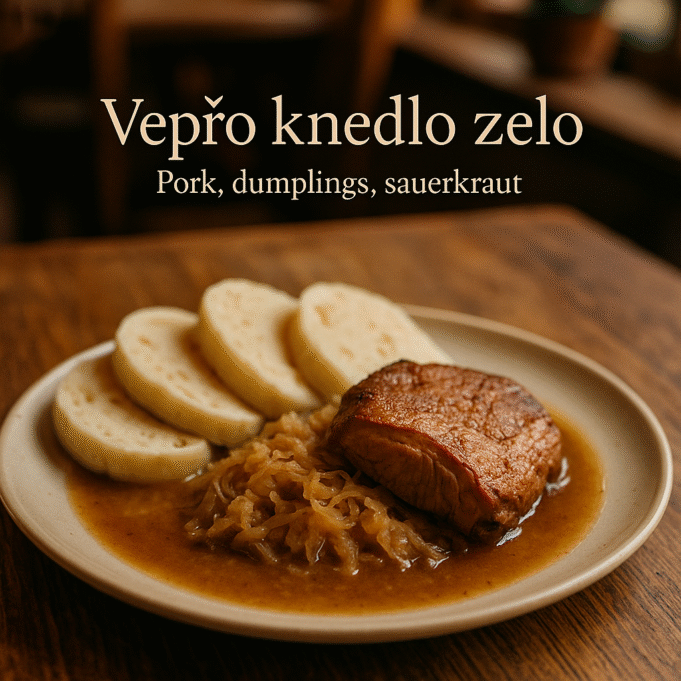Vepřo knedlo zelo – A Traditional Czech Dish You Must Try in Prague
About the Dish
Vepřo knedlo zelo is the very essence of Czech comfort food, a hearty classic that you absolutely must try when visiting Prague. This beloved dish brings together three harmonious parts: succulent roast pork (vepřo), pillowy bread dumplings (knedlo), and tangy stewed sauerkraut (zelo). When plated, the golden slices of pork, nestled alongside the soft dumplings and crowned with a mound of aromatic sauerkraut, create a feast for both the eyes and the senses. The pork is often slow-roasted until it develops a crispy crust yet remains juicy inside, while the dumplings soak up all the delicious juices. The sauerkraut, simmered with caraway and sometimes sweetened with apple, adds a vibrant, slightly sour contrast that elevates the entire meal. Each bite offers a medley of flavors and textures: savory, comforting, tangy, and utterly satisfying.
History and Cultural Significance
Vepřo knedlo zelo is deeply woven into the fabric of Czech food culture. Its origins trace back to rural kitchens, where pork was a staple thanks to traditional pig-slaughtering festivities known as zabijačka, which historically marked the winter season in Czech villages. Over the centuries, this dish became synonymous with Czech Sunday lunches and family gatherings, celebrated as the centerpiece of many festive tables. Its enduring popularity comes from both its simplicity and its ability to bring people together—few meals in Czechia evoke as much nostalgia and warmth as this one. Whether at a bustling Prague tavern or a countryside home, Vepřo knedlo zelo speaks to tradition, hospitality, and the Czech love for robust, satisfying meals.
How It’s Prepared
The preparation of Vepřo knedlo zelo is an act of culinary patience and care. Pork shoulder, often seasoned with garlic, marjoram, and caraway seeds, is slow-roasted until the edges caramelize and release mouthwatering aromas. Meanwhile, the dumplings are made from flour, yeast, milk, and often cubed bread, yielding a texture that is both soft and substantial—perfect for mopping up the pork’s rich pan juices. The sauerkraut is stewed gently, usually with onion, bay leaf, and a hint of sugar, allowing flavors to deepen and mingle. Across the Czech Republic, you might find regional variations—some adding a touch of smoked bacon to the sauerkraut, others spiking it with white wine or juniper berries. No matter how it’s prepared, the result is always comforting and deeply flavorful.
Where to Eat Vepřo knedlo zelo in Prague
To savor this iconic Czech dish, Prague offers an array of memorable settings, from rustic pubs to elegant dining rooms. You’ll find Vepřo knedlo zelo featured in both traditional and contemporary menus. Some top picks include:
- Lokál Dlouhááá – authentic Czech experience with a cozy atmosphere.
- U Modré Kachničky – elegant restaurant famous for traditional dishes.
- Café Savoy – modern take on classic Czech cuisine.
Tips for Visitors
- Pair it with a local Czech beer or Moravian wine for the best experience.
- Try it during lunch — many Prague restaurants offer it as part of their daily menu (denní menu).
- Ask for homemade dumplings if the dish includes them — they’re a true local favorite.
More About Czech Cuisine
Vepřo knedlo zelo is a proud ambassador of traditional Czech dishes, embodying the hearty, unpretentious style that characterizes local cuisine in Prague. While enjoying this classic, don’t miss the chance to try other staples of Czech food in Prague, such as rich beef goulash, roasted duck with red cabbage, or the delightful sweet treat of chimney cake (trdelník). Whether you’re dining in a centuries-old pub or a trendy bistro, Prague’s culinary scene is ready to offer you a true taste of the Czech Republic—history, hospitality, and heartwarming flavors on every plate.
Source: www.praguehints.com










